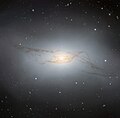| NGC 4753 | |
|---|---|
 NGC 4753 imaged by the HST. Note the distinct dust lanes surrounding the nucleus. NGC 4753 imaged by the HST. Note the distinct dust lanes surrounding the nucleus. | |
| Observation data (J2000 epoch) | |
| Constellation | Virgo |
| Right ascension | 12 52 22.0682 |
| Declination | −01° 11′ 58.597″ |
| Redshift | 0.003879 |
| Heliocentric radial velocity | 1163 ± 5 km/s |
| Distance | 72.0 ± 5.2 Mly (22.08 ± 1.59 Mpc) |
| Group or cluster | NGC 4753 Group |
| Apparent magnitude (V) | 10.85 |
| Characteristics | |
| Type | S0 pec |
| Size | ~128,000 ly (39.24 kpc) (estimated) |
| Apparent size (V) | 6.0 x 2.8 |
| Other designations | |
| IRAS 12498-0055, UGC 8009, MCG +00-33-016, PGC 43671, CGCG 015-029 | |
NGC 4753 is a lenticular galaxy located about 60 million light-years away in the constellation of Virgo. NGC 4753 was discovered by astronomer William Herschel on February 22, 1784. It is notable for having distinct dust lanes that surround its nucleus. It is a member of the NGC 4753 Group of galaxies, which is a member of the Virgo II Groups, a series of galaxies and galaxy clusters strung out from the southern edge of the Virgo Supercluster.
Physical characteristics
The distribution of dust in NGC 4753 lies in an inclined disk wrapped several times around the nucleus. The material in the disk may have been accreted from the merger of a gas rich dwarf galaxy. Over several orbital periods, the accreted material eventually smeared out into a disk. Differential precession that occurred after the accretion event caused the disk to twist. Eventually, the disk settled into a fixed orientation with respect to the galaxy. The age of the disk is estimated to be around half a billion to a billion years.
Another explanation suggests that the dust in NGC 4753 originated from red giant stars in the galaxy.
Dark matter
Analysis of the twisted disk in NGC 4753 by Steiman-Cameron et al. revealed that most of the mass in the galaxy lies in a slightly flattened spherical halo of dark matter.
Globular clusters
NGC 4753 has an estimated population of 1070 ± 120 globular clusters.
Supernovae
Two supernovae have been observed in NGC 4753:
- SN 1965I (type unknown, mag. 13.5) was discovered by Leonida Rosino on 18 June 1965.
- SN 1983G (type Ia, mag. 13) was co-discovered by Kiyomi Okazaki and Robert Evans on 4 April 1983.
Group membership
NGC 4753 is a member of its own galaxy group, known as the NGC 4753 Group. The NGC 4753 Group is located near the southern edge of the Virgo Cluster. The group, along with other groups of galaxies form part of a filament that extends off from the southern border of the Virgo Cluster that is called the Virgo II Groups.
Image gallery
-
 NGC 4573 imaged by the Gemini South Telescope
NGC 4573 imaged by the Gemini South Telescope
See also
References
- ^ "Results for object NGC 4753". NASA/IPAC Extragalactic Database. NASA and Caltech. Retrieved 2017-10-03.
- "Your NED Search Results". ned.ipac.caltech.edu. Retrieved 2017-10-04.
- Rojas, Sebastián García. "Galaxy NGC 4753 - Lenticular Galaxy in Virgo Constellation · Deep Sky Objects Browser". DSO Browser. Retrieved 2017-10-04.
- "New General Catalog Objects: NGC 4750 - 4799". cseligman.com. Retrieved 2017-10-04.
- ^ "Detailed Object Classifications". ned.ipac.caltech.edu. Retrieved 2017-10-04.
- ^ "The Virgo III Groups". Atlas of the Universe. Retrieved 2010-11-27.
- ^ Steiman-Cameron, Thomas Y.; Kormendy, John; Durisen, Richard H. (18 June 1992). "The remarkable twisted disk of NGC 4753 and the shapes of galactic halos" (PDF). The Astronomical Journal. 104: 1339–1348. Bibcode:1992AJ....104.1339S. doi:10.1086/116323.
- DEWANGAN, G. C.; SINGH, K. P.; BHAT, P. N. (11 May 1999). "Dust Properties of NGC 4753". The Astronomical Journal. 118 (2): 785–796. arXiv:astro-ph/9905352. Bibcode:1999AJ....118..785D. doi:10.1086/300963. S2CID 15602349.
- "New twist in the old search for dark matter. - Free Online Library". www.thefreelibrary.com. Retrieved 2017-10-26.
- Caso, Juan Pablo; Bassino, Lilia.; Gomez, Matıas (1 September 2015). "Footprints in the sand: What can globular clusters tell us about NGC 4753 past?". Monthly Notices of the Royal Astronomical Society. 453 (4): 4422–4431. arXiv:1508.07653. Bibcode:2015MNRAS.453.4421C. doi:10.1093/mnras/stv2015. S2CID 119287860.
- Gingerich, Owen (25 June 1965). "Circular No. 1912". Central Bureau for Astronomical Telegrams. Smithsonian Astrophysical Observatory. Retrieved 1 December 2024.
- "SN 1965I". Transient Name Server. IAU. Retrieved 1 December 2024.
- Kosai, H.; Kozai, Y.; Okazaki, K.; Evans, R. O.; Thompson, G.; Argyle, R. W.; Sinclair, J. E. (1983). "Supernovae". International Astronomical Union Circular (3789): 1. Bibcode:1983IAUC.3789....1K.
- "SN 1983G". Transient Name Server. IAU. Retrieved 1 December 2024.
- BUTA, RONALD J.; CORWIN, JR., HAROLD G.; OPAL, CHET B. (4 December 1984). "SUPERNOVA 1983g AND THE DISTANCE TO NGC 4753". Publications of the Astronomical Society of the Pacific. 97: 229–235. doi:10.1086/131522.
- ^ Karachentsev, I. D.; Nasonova, O. G. (3 December 2012). "Intense look at Virgo Southern Extension". Monthly Notices of the Royal Astronomical Society. 429 (3): 2677–2686. arXiv:1212.0840. Bibcode:2013MNRAS.429.2677K. doi:10.1093/mnras/sts557. S2CID 119119442.
External links
- NGC 4753 on WikiSky: DSS2, SDSS, GALEX, IRAS, Hydrogen α, X-Ray, Astrophoto, Sky Map, Articles and images
- De Vaucouleurs Atlas entry on NGC 4753
- NGC 4753 Lenticular dust in detail (NASA/ESA)
| Astronomical catalogs | |
|---|---|
| NGC | |